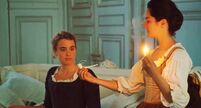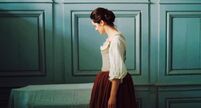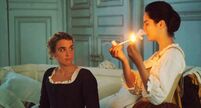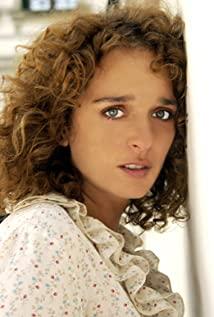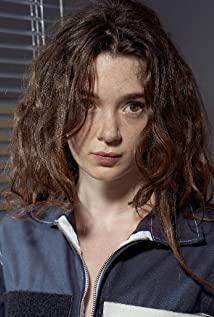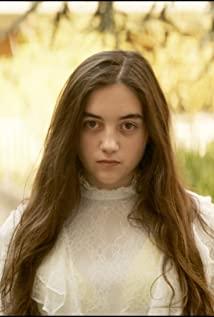"Draw my outline first, then the silhouette."
"Don't draw too fast."
"Spend more time watching."
Several young girls were painting portraits. Sitting in front of them was their teacher, Marianne, who was the model for sketching and instructing the students on the parts they should pay attention to. A student found a painting in the storage room and placed it in the studio, and when Marianne saw it, she asked who brought it out.
The student asked her, did you paint this picture?
Marianne replied, yes, that was a long time ago.
Marianne came to the island by boat, arrived late at night, and was received by a young maid. Marianne's father, also a painter, had painted a successful portrait of the Countess, and thanks to her father's relationship, the Countess hired her to paint a portrait of her young daughter, Eloise. From the maid's mouth, Marianne learned something about Eloise. Eloise's sister died before she got married, and Eloise, who was living in a monastery, had to replace her sister to marry a strange man who had never met in Milan. From the maid's suggestion, Marianne knew about Eloise's sister. His death was not an ordinary death from illness. Eloise was very resistant to this marriage. The maid also told her that a painter had come before, but he did not paint it. Marianne found the painting left by the painter in the room, it was a portrait of a headless woman in a green dress. The maid brought the green skirt and told Marianne that it was the only skirt, and the lady still wore her monastery clothes every day.
The Countess told Marianne that the portrait would determine the rest of her daughter's life, and as long as the other party was satisfied, the marriage would be done. Marianne was full of confidence in her artistry. The Countess reminded her that the reason for the failure of the last painter was because her daughter did not want to show him her face, and she refused the marriage and was unwilling to cooperate. Therefore, Marianne must not be discovered by her, and she must complete the portrait through secret observation. She asked Marianne to go for a walk with her daughter. Since she came here, she has forbidden her daughter to go out, and she knows that walking will make her happy. Marianne's task is to observe her daughter's face and write it down silently during the walk.
Marianne was arranging her painting supplies in the bedroom when the maid came in to announce that the lady was waiting for her to go out. Marianne grabbed the maid and asked the cause of Eloise's sister's death in detail. The maid had to tell her that they were walking on the edge of the cliff when Eloise's sister suddenly disappeared, and when she was found again, she had fallen to her death on the cliff Down. Marianne asked the maid if she saw her fall, and the maid said no, she chose to jump because she didn't make a sound.
Marianne recalled the reason why the Countess had explained to her why Lois was not allowed to go out—“I’m not strict enough with her sister.” She went downstairs worriedly, and downstairs was Eloise with her back to her and her hat on. .
Eloise walked very fast, running fast on the flat ground near the edge of the cliff, Marianne followed her closely, and when she came to the edge of the cliff, Eloise turned around and said to Marianne that this was what she had been doing for many years. desire to do things.
Thinking of her sister, Marianne blurted out, "Are you dead?"
Eloise answered her - "Run against the wind."
They returned to the villa, and Eloise borrowed a book from Marianne, who she doubted about her arrival, but left without questioning.
In the evenings, Marianne silently wrote down partial drawings of Eloise from the memory of her morning walk.
The next morning, when she was trying to paint Lois, the maid came in and said to her, Miss is waiting for you. She held a scarf in her hand, "I have to bring it for you, it's very windy outside."
Marianne followed Eloise, and they took a walk by the sea. Eloise stopped, knelt on the sand, and said, I want to go into the water. Marianne said, wait for the waves to calm down someday.
"How long will you be staying?"
"Can you swim?"
"Do not."
"It's very dangerous if you can't swim into the sea."
"What I'm trying to say is I don't know if I can swim."
Marianne didn't think too much about Eloise's words. Given her assignment, she had to focus all her energy on observation. She just smiled and looked down from Eloise's hands on her thighs. Later, while she was away, quickly drew the gesture of the hand. At night, she told the maid about her difficulties, and the maid suggested that she try to be friends with Eloise first.
Marianne and Eloise went out for a walk as usual. Marianne takes the initiative to ask about the cause of Eloise's sister's death. Marianne expressed her opinion and believed that Eloise's sister committed suicide. Eloise did not deny it. She said that her sister apologized to her for no reason in the last letter. She believed that the apology was because her sister had lost her fate. gave it to her, so my sister felt guilty.
Marianne asked her, "Is this marriage so terrible to you?"
Eloise asked her back, how much do you know? And Marianne knew the same as Eloise - a wealthy businessman in Milan.
A marriage partner without feelings, a fate without a way out, and a life without the right to choose, these make Eloise afraid. She finds life in a monastery a joy, where there is an equal life, there is a self-existence, that is, the rights of unmarried women, and when entering married life, the husband's status is higher than that of the wife, and the wife is to obey her husband and do housework for him, Having children is equivalent to being deprived of personal freedom. It is an unfair life, and she resists marriage in her heart.
Marianne shrugged this off, pointing out that there would be no equality anywhere, that she had lived in a convent where she was often punished for painting, and that much of what Eloise believed was freedom because of her identity illusion.
"You can draw?"
"Yes, a little bit."
Eloise asks Marianne, will you ever get married? Marianne replied that she did not know.
"No one forced you?"
"No."
Eloise believed that Marianne had a choice, so she couldn't understand her situation. Marianne denies this.
At night, the Countess came to ask Marianne about the progress of her painting. Marianne said that she needed time to paint, and it was usually evening when she returned from a walk. She suggested that the Countess could let Eloise go for a walk alone. She was not sad, she was just angry at the arrangement. The Countess stated that she had suffered the same thing. As a woman who had to face things, she didn't want to marry her daughter to a rich man because of money. She was for her daughter's good and hoped that she would live a worry-free life. life. Marianne pointed out sharply that this marriage also carried the Countess's own hopes for the future. The Countess did not deny it, and she did not resist new changes. "If you don't know Paris you can go to Milan with me." There she would introduce Marianne to painting, and it all depended on Eloise's portraits. At night, Marianne continued to paint Lois, but she was not satisfied with her paintings.
The next day, Marianne put on the green dress and sat in front of the mirror to observe the shape, details, light and shade of the light, the turning of the folds, when Eloise's voice came from outside the door, and Marianne hurried back to the curtain Behind the scenes, take off your skirt.
When she came out dressed, Eloise was sitting in her previous seat, Marianne worried that Eloise had discovered her identity, and Eloise saw her and stood up and asked if she was There is smoke. Marianne took the opportunity to divert her gaze quickly and told her that the Countess agreed that she should go out for a walk alone tomorrow.
Eloise didn't have the happy expression Marianne imagined. She looked lonely and said, does freedom mean loneliness? And this unfounded sadness soon disappeared. She continued, "Tomorrow I'm going to Mass."
"For music?" Marianne laughed. "The organ is beautiful, but it's the music of the dead."
Eloise said that was the only music she ever listened to. Marianne asked if she had never heard an orchestra? Lois shook his head, asked her if she had heard it, and described that feeling to her. Marianne shook her head. Music is difficult to describe in words. Then, she came to the piano placed in the room and played the summer in Vivaldi's "Four Seasons".
"It describes the coming of a storm, with all the insects chirping, frogs roaring, followed by a torrential rain, lightning and thunder..."
Marianne was focused on her playing, and she did not look up. Eloise, who had always been stern and eccentric, now had the tenderness on her face—she smiled. Looking at Marianne who was carried away. Marianne, ignorant of this, stopped playing, shook her head and said to Eloise: "I don't remember how. You have a chance to hear what follows. Milan is a city of music."
Eloise's expression changed instantaneously, and she returned to being cold and eccentric, responding to Marianne's enthusiasm with a sarcastic tone: "I can't wait."
Marianne thought Eloise was mad, and she didn't understand why Eloise was mad at her, explaining, "I just wanted to tell you that there are good things out there too."
There was already a fire of love burning in Eloise's heart, and she was sad that Marianne didn't understand her anger, but she couldn't confess her heart, so she could only use more hostile accusations to relieve herself "You're just trying to comfort me and numb the pain," she said.
The two broke up unhappily.
While Eloise was away at Mass, Marianne had the maid put on a green dress and sat on a chair, and she began to perfect her painting. Later in the afternoon, when Eloise concluded her Mass, she came to the bedroom of Marianne, who had just finished her portrait and had not yet washed off the paint on her right hand. She put that hand nervously behind her back, avoiding the point of view that Eloise might have spotted, and she was cautious but had to pretend to be pleasant, and asked Eloise kindly how he was doing today.
Eloise had a great time today. Through this solitude, she became more and more sure of her own feelings. She looked at Marianne with frank eyes and said, "I feel the freedom you speak of in loneliness, I also realize that you are indispensable to me."
When Marianne heard this, her heart skipped a beat, but she didn't say anything. During the night, Marianne told the Countess that the portrait was finished. The Countess asked her if she was satisfied, let's go and see. Marianne said her request—she wanted Eloise to be the first to see the painting.
Then, she has to tell Lois who she is.
The Countess agreed, knowing that the two had developed a friendship, she expressed that she could understand Marianne's request, and told her that Eloise also liked her very much, and always talked about Marianne.
When Marianne heard this, her guilt deepened. She went back to the bedroom and took out the painting of the previous artist. The candle lit the neck in the painting. She looked at the painting that was gradually burning. An indescribable emotion, a flint that burns itself in the stuffy stove.
Marianne tells Eloise the truth on the beach, she is a painter and the painting was done last night. Eloise asked her if she was leaving. Marianne said, yes, go later, go with your mother.
Eloise looked at Marianne, and she said, "Today is the day I go into the water." After saying that, she took off her clothes and went into the sea barefoot. After staying at sea for a while, he returned to shore, shivering. She wrapped herself tightly in her clothes.
Marianne looked at Eloise, who was obviously cold, but put on a nonchalant face. She wanted to laugh in her heart, and asked in a teasing tone, "Do you really know how to swim?" Then she smiled, " You float well."
"Let's go back."
Eloise shook his head, and brought the conversation back to Marian's confession to her. "I finally understand the way you look at me." She looked at Marianne angrily, expressing her anger.
Marianne took her to see the portraits she had painted.
Eloise watched silently for a while, and Marianne asked her opinion. She shook her head, thinking it wasn't her, and asked Marianne, "Is this me in your eyes?"
"It's not just me."
"How come it's not just you?"
"It also includes the rules of painting, techniques, the use of color and light."
"But it's not fresh, I can't feel the existence of vitality."
"That's just a flash in the pan. A portrait that pursues vitality will lose its true essence as time passes."
"Not everything in the world is so ephemeral, such as deep love, from the heart. This portrait is not like me, I can understand, but it does not seem to be by you, and I feel sorry for it."
"Why do you judge like that? I didn't know you were still an art critic."
"I didn't know you were a painter either."
Eloise was indeed angry that Marianne had lied to herself, but she was even more angry that Marianne didn't see her - Eloise in the picture was Marianne's imaginary self, not her. Marianne is only to complete the task of the countess, if the portrait does not belong to the master, then the painting is a failure, it loses the character of the character and becomes a vague cloud.
In this regard, on the one hand, Marianne knows that she is justifying the so-called distance between the painting and the reality to add beauty and to look like it in the future. She was moved and angry, but she couldn't convince Eloise, and at the same time she couldn't convince herself, she looked at the portrait and wiped Eloise's face with a cloth angrily.
When the Countess came to see the ruined portrait, she was angry, thinking that Marianne was playing with her and wasting her time, and she ordered Marianne to evict her. Marianne begged the countess to give herself another chance, at which point Eloise told her mother that she wanted Marianne to stay and that she would cooperate with Marianne as a model for the portrait.
The Countess, surprised, came to Eloise, looked at her and asked why. Eloise nonchalantly points out that it doesn't matter what the cause is, it's the painting that matters, to you, doesn't it matter? The Countess promised Lois, "I'll be away for five days, and when I come back, I'll see that the portrait is finished. I'll have the final say, not you."
After saying goodbye to the Countess. Eloise put on the green dress, and Marianne began to teach her how to sit. "look at me."
At night, when Marianne had her period, the maid wrapped the burnt stone in a piece of cloth and handed it to Marianne to put it on her stomach. She said, "Usually I will prepare one, but I haven't come in these months. Now." The maid told Marianne that she was pregnant, she didn't want a child, and she secretly resolved the matter after the hostess left.
Marianne told Eloise about this, and the three discussed how to abort the maid. The maid ran back and forth by the sea, and then they searched for herbs for abortion on land, returned to the villa, and cooked in the kitchen. After the maid was dressed, she stepped on the chair and hung it in a vertical position. Who came up with these methods? Eloise asked Marianne, "Have you been through this before?"
"right."
"Do you know what love tastes like?"
"knowledge."
"how?"
"Indescribable."
"I'm asking you what it feels like."
At this moment, the maid fell weakly to the ground. The two helped her to Marianne's bedroom. Marianne lit the fire and found Eloise asleep in her bed too. Looking at Eloise's sleeping face, she gently picked up her drawing tools, picked up a pen, and drew Eloise's sleeping face.
Eloise didn't really fall asleep, she squinted to see Marianne drawing her, so she changed to a more open position for Mary to draw, and smiled slightly for Marianne to continue. Marianne received Lois's meaning and knew that Eloise was no longer angry with her.
Eloise's portrait is almost complete, but Marianne is still haunted by what's missing, saying: "I can't make you smile, every time I think I'm close to making it, it's fleeting."
Aside, Eloise, still sitting in a chair, joked: "Anger always wins over happiness."
Marianne agreed: "Especially you." After noticing the change in Eloise's face, she added: "I have no intention of hurting your feelings."
"It's not really hurtful," Eloise said.
"No, I can see that," said Marianne. "When you're nervous, you clench your hands. When you're embarrassed, you bite your lower lip. When you're jealous, you don't take your eyes off of it." It was the change in Eloise's mood that she observed while painting.
Eloise said with words: "You know me well."
"Forgive me, you must not like being looked at like this."
Eloise shook her head. She felt sorry for Marianne's cautious attitude, but she couldn't help but face her feelings. She said, "We are equal, and there is no difference. Please come here, come here."
Marianne came to her, she motioned for Marianne to come closer, they turned to where Marianne was painting, and Eloise said, "Look, when you look at the person in the painting, who am I looking at?"
Marianne is not suffering, but she still has worries in her heart. She doesn't know if it's good or not. This relationship is destined to be short-lived, and this relationship is destined to hurt them. . Eloise went on to say: "When you're in a quandary, you nod your head and rest your forehead; when you're embarrassed, you raise your eyebrows; when you're nervous, you pant."
They looked at each other, eyes flowing, affectionate, Marianne left Eloise before she lost control, she went back to the easel, but she couldn't calm down anymore, she pretended that she could concentrate on painting, The conversation between the two ended there.
At night, the three of them gathered in the kitchen to play cards again. During the days when the Countess was away, through Marianne, Eloise and the maid got closer, and the three of them had a good time. In the presence of others, the problem between Eloise and Marianne slipped into the depths again, and the spark of tension resurfaced when it was just the two of them.
Eloise's portrait continues. Marianne begins to draw the part of the green skirt below the neck. Eloise asked Marianne if she could draw nudes? Marianne replied, "Female nudes."
"Why not draw men?"
"I don't have that right."
"why?"
"Because I'm a woman."
"Are you afraid of injuring yourself?"
"It's to prevent women from having the opportunity to paint great works. Most female painters of the subject can't paint without understanding the male body."
"How did you do it?"
"I'm secretly painting. It doesn't hurt."
(Since ancient times, the status of women is lower than that of men. I once read a sentence in a book: Men do not belong to women, but women belong to men; no man is created for women, but women are created for men The story is that God created Eve by taking a rib from Adam's body. Eve's existence is for Adam and for the reproduction of mankind. A wife should obey her husband. Later, Eve "tricked" Adam into eating the forbidden fruit, and some people began to say - Of all the beasts, none is as destructive as women . Wait, the news, the family relations that I saw, despite the men's desperate efforts to hide their inner superiority, saying that there is no such thing, No matter from which point of view, women are indeed inferior to men. In such an atmosphere, women's self-deprecation is often seen. I have to say, it is true, despite the inner denial.)
The three gathered in the kitchen again, the maid embroidered the flower towel, Eloise prepared the food, Marianne took out the wine glass and poured the wine, Marianne watched Eloise without a lady attitude, diligently and wisely cooking everything , she was happy and satisfied with this peaceful and comfortable relationship.
After dinner, they sat in a circle, and Eloise read to them what he had read in the book. It was a love story in ancient Greek mythology.
In Greek mythology, Orpheus was the son of Apollo, the sun god, and Calliopa, the goddess of literature and art. His lyre and singing can confuse animals. Orpheus married a young girl, Eurydice, as his wife. The two fell in love with each other and lived a happy life. Unexpectedly, one day Eurydice was bitten by a poisonous snake while walking outside, and the venom spread all over his body. Orpheus was in agony holding the body of Eurydice who was dying. He wept day and night, unable to bear the pain of losing his beloved, so he took the lyre to the underworld and begged the king and queen of the underworld, hoping that they could return his wife to him. Hades was deeply moved by his lyre and singing, and he agreed to Orpheus' request, allowing him to return to the world with his wife. The Queen of Hades handed Eurydice's soul to Orpheus herself, and said to him: "You go ahead, and she follows. Before you leave Hades, you can't look back at her, no matter what. Talk to her, or you will lose her forever." But before the exit of sunlight could be seen, Orpheus looked back at Eurydice, and Eurydice's soul fell from his hand into the abyss forever, and Nor could he return to Hades to see Eurydice again.
Marianne, Eloise, and the maid had different opinions on the issue of Orpheus' return.
The maid thought that Orpheus should act according to the agreement in order to be reunited with his wife. It was his fault that he let his wife die again. Eloise thought that holding the hand of the one he loved, how could he not look back at her?
Marianne, who agreed with the maid on the one hand, and denied that it was Orpheus' fault on the other, said, "Yes, he can hold back, but there is a reason why he turned back, perhaps because his wife called her, His choice was not as a lover's choice, but as a poet."
(As a poet's choice? I think the so-called poet's choice may be talking about a kind of broken beauty, the lingering memory of love, and a relationship with regrets will be more unforgettable? As a story, it is regrettable Stories probably touch the softer parts of human emotions more than perfect stories. It seems so sad when the priest and the heroine broke up in the last episode of "London Story" not long ago. Just think about it, If the wife doesn't know Orpheus's pact with the Queen of the Underworld, she begs her husband all the way to look back at her, if Orpheus really loves her, can he resist not looking back? He can so cruelly ignore Is his wife's call? Maybe he was moved by his wife's call at that moment, and he couldn't help but turn his head. He couldn't ignore his wife's pain. He forgot the rules. Will you choose to love or not to love, and does love have to be an entity? If it becomes a memory, would you still call it love? Actually, I feel lucky to have it, bitterness, tingling, tears are proof that the process has How sweet, how many unforgettable loves can one have in one's life? Very few, some people may not be able to get such satisfaction in their whole life. Although they have not been able to spend their whole life with the person they love, the beauty of love remains. In my mind, this is enough.)
Eloise agreed with Marianne.
In order to confirm the status of the baby, the maid went to the village to find experienced women. Marianne and Eloise went with her. The women in the village set up a bonfire in the open space, and people started talking around the bonfire. This is their salon. Eloise took off her coat in order to blend in with the atmosphere. The maid came to Marianne and said, "The child is still here, and she asked me to come back in two days." Marianne comforted her and promised to face her with her.
At this point, the scattered women began to gather, clapping their hands and singing, which Eloise and Marianne found both novel and delightful. Opposite Marianne, Eloise stood there.
The fire seemed to burn Eloise, Eloise watched Marianne, walking slowly, the bottom of her skirt was on fire, and Emmanuel was still struck by the burning love in her eyes, or Said to be shocked by the fire of love in her own heart. At this time, two women gathered around and put out the fire.
Eloise and Marianne went for a walk by the sea, and Eloise went into the cave and waited for Marianne. Marianne walked up to her, and the two couldn't help kissing. This time, it was Eloise who broke free. Marianne hurried back to the villa and came to the kitchen. The maid was preparing lunch. The maid told Marianne that Eloise was not feeling well and would not eat dinner.
Marianne returned to her bedroom with the candlestick, she stopped, turned around, turned around, and saw Eloise wearing a white robe in the dark aisle, her body glowing white, she did not see Eloise clearly. look, the wonderful sight disappeared. Marianne wondered, thinking it was because she was thinking of Eloise, and then, when she went back to the bedroom, she saw Eloise standing in front of the fire.
She stepped forward, put her head on her shoulder, and said, "I thought I scare you."
Eloise said, "You're right, I'm scared."
Eloise confided his love for her to Marianne, and the two finally put aside their guesses and hugged happily.
The maid knocked on the door and asked Marianne if she remembered the promise she had made. Marianne said to Eloise, "Get up."
The three came to the door of a small house, and the maid paced back and forth nervously. The door opened, a little girl helped the maid undress, another woman was stirring something, and the oldest one came to the maid, she made the maid lie down, spread her legs, she seemed very good at dealing with this kind of thing. experience, she proceeded calmly and ruthlessly. Marianne couldn't bear to look directly, Eloise told her to watch carefully, the maid showed a painful expression, and a little boy lay beside her. At the end of the moment, the maid turned her head and looked at the little boy, feeling a sense of her own situation. Sad and guilty, she sobbed softly.
At night, the maid rested in Marianne's bedroom, and Marianne asked Eloise to go back to her room to sleep, and she could take care of the maid. Eloise didn't want to sleep, she asked the maid if she slept, and the maid replied that she couldn't sleep either. Eloise got the maid out of bed, and she asked Marianne to draw what they saw in the morning and what the maid experienced. Marianne understood what she meant and agreed.
Eloise's portrait is in the final stages. Now, they stared at each other, and there was no anxious atmosphere that was caused by not being able to confirm each other's intentions. The two of them smiled and felt affectionate. Eloise winked at Marianne like a happy little girl, and Marianne had to put on a serious look and said, "Don't make trouble. Be serious." But she was as happy as Eloise in her heart, So she came to Eloise and kissed her.
At night, as Marianne walked in the darkness with the candlestick, the fantastic vision she had seen then reappeared - Eloise in a white robe, glowing with white light, and when she turned away, The illusion disappeared again.
The appointed time drew nearer, and Eloise's portrait was finished. The two looked at the painting, and Marianne said to Eloise, "I'm satisfied this time."
Eloise talked about the last time Marianne destroyed a portrait, Marianne said to her, but this time I want to destroy it too. The two finally spoke to the end. Marianne confesses her feelings that the painting will take away Eloise. Eloise was angry, sad and angry that Marianne cared only about her own feelings, not her situation.
"That's too bad. Do you think I'm at the mercy of me and blame me?"
"No."
"No, that's how you feel. You're not by my side. You blame me for what's about to happen. It's not my fault. What's your position?"
"You are right."
"Go on. Say what's on your mind, you're not as brave as I thought."
"You're not as brave as I thought."
"We've come this far, and you think I'm submissive, and not only that, you think I've failed you, don't you? You think I'm happy about it."
"Just to stop thinking."
"You can imagine my happiness or misfortune, as you wish, but please don't consider me a sinner . You want me to resist, don't you?"
"yes."
" But do you dare to tell me yourself ? Please answer me."
"I can not."
The maid's silk scarf is complete. Marianne came to ask the maid where Eloise was, and the maid said she was not in the room and informed the Countess Marianne that she was coming back in the morning. Marianne hurries to the beach, worried that Eloise will make an extreme choice. When she saw Eloise, she wept and hugged her tightly, begging for her forgiveness, and she told Eloise her mother's news that the two were agonizing over the separation they were about to face.
The two returned to the studio, and Marianne asked Eloise to come by her side. The two stared at the portrait on the easel. Eloise asked, "When do you decide to stop writing?" Marianne replied, "There is such a thing as a In an instant, the pen stops on its own."
Eloise wanted Marianne's painting, she thought about being able to think of her through Marianne's flowers in the future, Marianne agreed to paint her own face, she opened the storybook and turned to page twenty-eight , and drew his own image in the blank space.
On the last night, the two resisted sleepiness and forced their eyes open, "Don't sleep, don't sleep."
"I have a new feeling?"
"what?"
"regret."
"Please don't regret it. Remember."
"Portrait of a Woman on Fire" is a film directed by French director Celine Sciamma, which premiered at the Cannes Film Festival on May 19, 2019, and won the Best Screenplay Award. Its plot is not complicated, it belongs to the type of long flowing water, it does not have much dialogue, and the emotional ups and downs are not obvious. I am afraid that only the waves and wind are the most turbulent in the whole film. Can this undercurrent and hidden fire lead the viewers to enter the movie? Deep down, this test tests the actor's understanding and grasp of the role, and in the film, whether it is Marianne and Miss Eloise who play the painter, or the Countess and the young maid who play the supporting role, they all digest the role requirements very well. The restraint and beauty they accomplish.
It's actually a bit like a documentary, an affair of a brilliant painter, or a secret affair of a legendary duchess.
"Portrait of a Burning Woman" borrows the love story between Orpheus and Eurydice in ancient Greek mythology. In the second half of the film, Marianne saw the vision and when they separated, Elo in white gauze Iss calls Marianne on the stairs to turn her back, and this is the last scene before Eurydice and Orpheus are separated. Later, Marianne painted their farewell scene in the image of Eurydice and Orpheus, and in the exhibition she also saw a portrait of Eloise - she held her daughter's hand, and the other A book in one hand, it was their twenty-eighth page. Later, the two also met at a concert where Marianne had played Vivaldi's "Four Seasons" for Eloise, in which they never looked at each other, but Through music, through each other's memories, the two have met.
According to my understanding, part of the film is about the meaning of love, even if we can't spend our whole life together, this love is still intact. As long as it is true love, it can withstand the loss of years, and can still feel the existence of the lover in the loneliness and emptiness. Separation is no longer love's worst enemy. The other part is to express the difficult situation of women's freedom, from Eloise's sister not being allowed to express her resistance by death, the portrait determines the success or failure of Eloise's marriage, the background is set in eighteenth century France, even if The noble lady also has no right to choose, and the male power that is invisible in the whole movie - that village where there are only women in the imitation fluorine, but there are still births and abortions going on, so I can understand that the movie is called "Burning Woman" for the sake of portraits.
View more about Portrait of a Lady on Fire reviews




